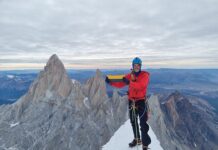
Lithuanian blogger Mantas Brazdžionis explores Lithuania for unique sites that are not on the usual itineraries. He shared his findings with LRT.lt, with photos from his personal album.
The Lyduvėnai Bridge in Raseiniai District is the longest and tallest bridge in Lithuania was only opened to the public last year. “There is also a pedestrian path that winds under the bridge and can be walked with a guide. To make it safe, visitors are given helmets and vests, and a guide explains the history of the bridge,” said Brazdžionis.
Visitors to Druskininkai are familiar with the cycling and hiking trails along the Nemunas River, but Love Island is less familiar, and a perfect place to watch sunsets. “You can’t get to Love Island in the middle of the river, but there used to be a bridge in the old days, which made it a popular date spot. Now, the island can be admired from a viewing platform at the bend of the river. The views are truly spectacular,” said Brazdžionis.
 The only real cave in Lithuania, Čiobiškis Cave in Širvintos district is an untouched work of nature that offers beautiful views and interesting legends. “Since the cave is located above a stream, on top of a slope, you have to be careful when hiking up to it. However, for those of us who are used to Lithuanian plains landscapes, the view here is truly spectacular. It is said that thousands of years ago it was inhabited by several families of cavemen, and during the Soviet era, Lithuanian youths used to hide here to escape from the draft,” said Brazdžionis.
The only real cave in Lithuania, Čiobiškis Cave in Širvintos district is an untouched work of nature that offers beautiful views and interesting legends. “Since the cave is located above a stream, on top of a slope, you have to be careful when hiking up to it. However, for those of us who are used to Lithuanian plains landscapes, the view here is truly spectacular. It is said that thousands of years ago it was inhabited by several families of cavemen, and during the Soviet era, Lithuanian youths used to hide here to escape from the draft,” said Brazdžionis.
In Vilnius and Švenčionys districts the Neris and Žeimena rivers intersect and are connected by three different bridges. “One train bridge was built by the Germans – it’s no longer in use, but it’s still standing almost intact. There is a newer bridge next to it, which still carries trains to the eastern side of Lithuania. You will also find a suspension footbridge. All the bridges offer different panoramas of the intersecting rivers, and this place is a favourite with photographers and wedding guests,” said Brazdžionis. It takes just half an hour to reach this place from Vilnius by car. Look for the Santakos Pedestrian Bridge for easy access.
Brazdžionis has discovered an abandoned chapel in the Ukmergė district, and says this place is for the adventurous. The chapel is located close to the village of Antakalnis near Ukmergė, just off the Vilnius-Panevėžys motorway. Although it is only a few hundred metres from the road, the chapel is not visible when driving. You won’t be able to drive up to it either – you’ll have to trudge through fields and woods to get there. But that’s the fun of it,” he says. It was difficult to reach the site, as the paths have long since been overtaken by nature. It used to be the site of the Poklevskis-Kozels nobleman’s estate complex. Now, the only reminders of its existence are the avenue of trees leading to the main manor house and the old chapel, built more than a hundred years ago. It is quite small, and could probably accommodate only a few people.
 The neo-gothic chapel, built by craftsmen from Latvia, was used for services and to celebrate Easter. Today, the yellow brick building is abandoned.
The neo-gothic chapel, built by craftsmen from Latvia, was used for services and to celebrate Easter. Today, the yellow brick building is abandoned.
Kruonis gravity hill in Kaišiadorys District is near the town of Kruonis. There are only a few of them in the world. This is the place to experience an optical illusion: you’ll think you’re driving up a hill, but you’ll be actually going down a paved stretch of several hundred metres through the forest. Interestingly, there are no buildings or towers to guide you as you approach it. The experiment can also be done with a ball, explains Brazdžionis.
Baltosios Rožės Bridge in Alytus is the highest pedestrian and bicycle bridge in the country, once also used for railway. The tracks ran through remote and wooded areas. One of them, a 19th century tunnel over 60 metres long, the Moterties Stream Tunnel, is still preserved today.
“During the Second World War, the tunnel was used to shelter locals from air raids.
In Šalčininkai district, the Rūdnininkai Forest features stretches of seaside-like sandy dunes.
In the old days, it was a military training ground, and planes used to drop bombs there. They began to destroy the vegetation, and the decreased until only sandy fields were left.
Today the Rūdnininkai dune is protected by a barrier and can only be accessed with the permission of the military. Visitors are advised to call the number indicated at the barrier and ask to be allowed inside.
The only natural waterfalls in Lithuania are in Trakai District, hidden in the forest near the village of Žemieji Semeniukai. The blogger explains that it takes a while to get there and you have to wade through a small dense forest. The Vilsa stream is tiny, just five kilometres long. Over the years, it has naturally formed various waterfalls. The biggest waterfall is only about 1.5 metres high.
Kretinga District is home to an abandoned prison. Dimitravas is a remote village in the depths of Žemaitija, hiding fascinating stories. According to Brazdžionis, on the initiative of the counts of Zubovai, a manor house was built there in the 19th century. During the interwar years, it was turned into a prison for forced labour. Criminals and political prisoners were housed there for about eight years, with up to 200 people interned there at a time. The former manor house is now tucked in between residential buildings. The building, although derelict, is truly unique: it is made of dark-coloured stones, with bars on the windows and a new sculpture next to it.



























